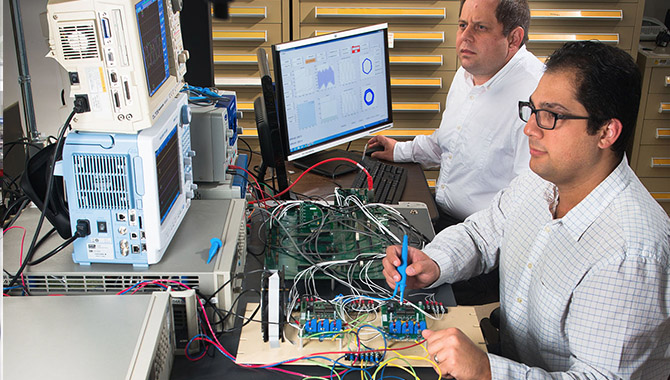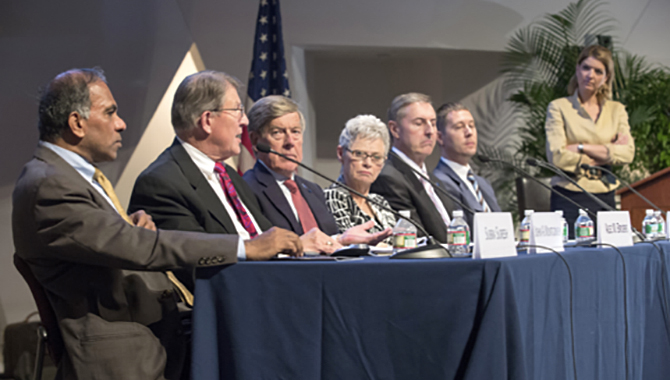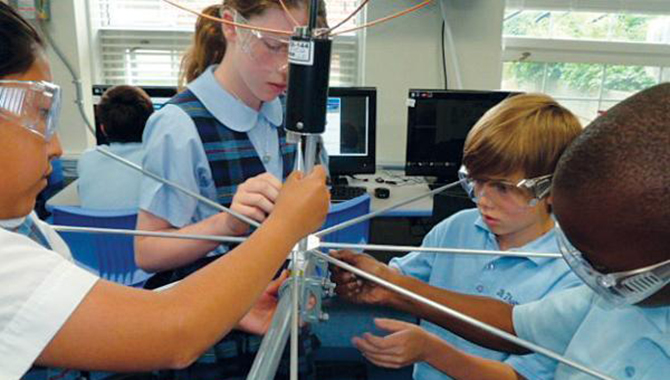
Technologies developed by NASA engineers are designed to advance mission success at the agency and often enhance life on Earth as well. Here, engineers at Glenn Research Center (GRC) test an electrical motor that will drive a small, conical pump designed to help circulate blood in children born with a single heart ventricle.
Credit: NASA/Bridget Caswell
During National Engineers Week and throughout the year, NASA spotlights the crucial role of engineers in developing solutions to advance space exploration and enhance life on Earth.
National Engineers Week was introduced in the U.S. in 1951 as an annual opportunity to highlight the important contributions of engineers to the nation and the world. A key focus of the week is to engage the next generation of engineers. Practicing engineers, educators, and organizations utilize a range of activities to bring the field to life for students as a means of fostering interest in STEM fields: science, technology, engineering, and math. Across the country, more than 70 engineering and educational organizations participate along with over 50 corporations and government agencies. The event occurs each year during the week of George Washington’s birthday, who is celebrated as the nation’s first engineer.
NASA’s involvement in National Engineers Week is an extension of the agency’s ongoing commitment to raising awareness of the importance of STEM. The agency leverages its diverse roster of engineers to spark dialogues with students about the ways in which engineers enable the development of technology used for space exploration as well as life on Earth. For 2017, NASA’s Digital Learning Network hosted a day-long series of live-streamed discussions with female engineers from across agency centers. Participants represented a wide range of engineering disciplines—from aerospace to mechanical to systems and more—and included early-career employees as well as those with decades of experience. The goal of the speakers was to highlight the value of STEM studies in expanding their college and career options. In each case, the speakers discussed how becoming an engineer led to an exciting and satisfying career at NASA.
Charlie Blackwell-Thompson, launch director for the Ground Systems Development and Operations Program for Exploration Mission-1 (EM-1), inspired students as the first woman to oversee a NASA liftoff and launch team. She said that she studied engineering after asking a high school teacher what kind of job she would be qualified to do with an engineering degree. He responded, “What kind of job couldn’t you do if you had an engineering degree? […] You will be amazed at the opportunities and the doors that that line of study, that degree, will open up for you.”
Research engineer Julie Kleinhenz, from Glenn Research Center (GRC), said, “I decided to do engineering because I wanted to be an astronaut. I looked at the different ways you could become an astronaut, and I guess engineering appealed to me because it’s kind of problem solving and figuring out how things work.” She added, “Once you have experience and a knowledge base of the basic physics principles […] you can pick your path and go in different directions.”
Both she and fellow GRC research engineer Ashlie Flegel said they had not experienced discrimination for being female in a traditionally male-dominated field. “Especially at NASA, the diversity is pretty wide here, so it’s a good working environment,” said Kleinhenz.
Flegel pointed out that students may face other barriers, but encouraged them to persevere. “Even when I was young and going around saying, ‘I want to work for NASA,’ [there were] people saying, ‘Oh, you can’t do that. You’re not smart enough, you’re not this, you’re not that.’” She added, “I was like, ‘I’m going to prove you wrong.’ And I did.”
Blackwell-Thompson offered guidance based on personal experience. “If you want to be an engineer, find that piece of engineering that you’re passionate about. The thing that you love. Because when you come to work every day or when you’re pursuing a career, to me there’s a difference in the verbiage ‘I have to go to work’ and ‘I get to.’ I get to be a part of America’s space program. I get to be a part of a launch team. And that’s a really exciting feeling.”
In addition to sponsoring public events for the next generation of engineers, NASA celebrates National Engineers Week with employee-focused events at centers as well. But agency support for its engineers does not conclude at the end of the week. NASA leadership supports APPEL in offering fundamental courses for the NASA technical workforce, such as Foundations of Aerospace at NASA and Project Management & Systems Engineering, as well as in-depth courses that span a critical range of disciplines related to agency missions. In addition, interactive professional development tools, such as the Project Management & Systems Engineering (PM&SE) Competency Model and the PM&SE Career Development Framework, are available on the APPEL website. These resources can be employed by NASA practitioners, managers, and supervisors to help chart a clear path for career growth.
The agency also supports hands-on development programs to accelerate the capabilities of practitioners at NASA. The Office of the Chief Engineer (OCE) and APPEL support the Systems Engineering Leadership Development Program (SELDP), a comprehensive initiative for mid-career professionals. Early-career practitioners can benefit from Rocket University and Project HOPE [Hands On Project Experience], which provide on-the-job learning experiences that promote professional development and readiness to lead.
By elevating awareness of the importance of STEM while fostering the professional development of NASA’s technical workforce, the agency underscores the critical contributions of engineers in advancing mission success and building a bright future for the nation.
Visit the APPEL Catalog to learn more about courses available to NASA’s engineers and other practitioners.
Explore the PM&SE Competency Model and PM&SE Career Development Framework.
Learn more about hand-on development programs such as SELDP, Rocket University, and Project HOPE.
Read an APPEL News article about ground-breaking technologies developed to support NASA missions that also enhance life on Earth.









